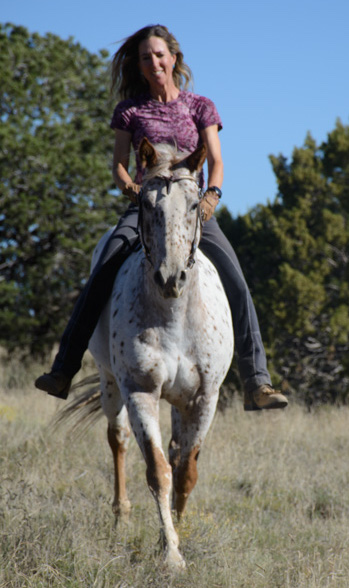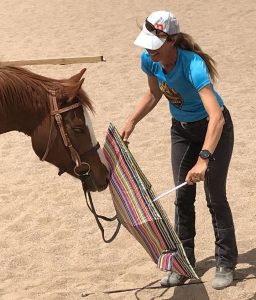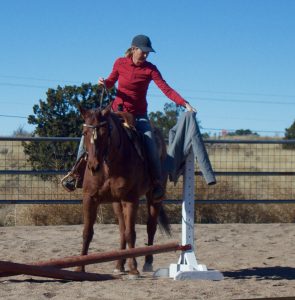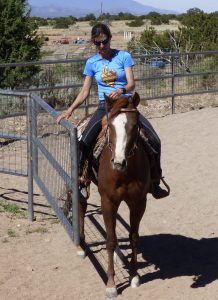 Katrin Silva grew up riding dressage in Germany before moving to the United States at age 19 to learn to ride Western. She’s been riding both disciplines for the last twenty years.
Katrin Silva grew up riding dressage in Germany before moving to the United States at age 19 to learn to ride Western. She’s been riding both disciplines for the last twenty years.
Silva has competed successfully through fourth level dressage on quarter horses, Morgans, Arabians, Hanoverians, and many other breeds. Based in New Mexico, she enjoys improving horse-rider partnerships and believes that good riding is always good riding, no matter which type of tack a horse is wearing. Check out her blog here.
By Katrin Silva
I’ve been called too sensitive all my life. Raised voices make me uncomfortable. Violent movie scenes give me nightmares. Snarky comments make me cry.
“Toughen up!” is a phrase I heard over and over, first as a child in school, then as a young horse professional, as an assistant trainer, as a woman in a universe still dominated by men.
For a long time, I tried to follow this piece of advice. I looked at my sensitivity as a drawback, as something I needed to overcome if wanted to make it in the horse business. Only in the last few years have I become proud of this label.
One reason for the shift is that I’ve always done well with sensitive horses, those labeled as too reactive or too difficult. Some trainers don’t want to work with them, but, in fact, I find that they’re easier to work with than thicker-skinned horses, as long as you know how to approach them.
 My goal is to get a horse to listen without overreacting, to make a horse attentive but not worried. An important part of my job is to help each horse find his unique Sensitivity Sweet Spot. This magic zone between detachment and overstimulation is the only place where learning happens.
My goal is to get a horse to listen without overreacting, to make a horse attentive but not worried. An important part of my job is to help each horse find his unique Sensitivity Sweet Spot. This magic zone between detachment and overstimulation is the only place where learning happens.
While tension and anxiety interfere with horse-rider communication like loud background noise, a detached, disengaged horse makes the conversation one-sided and nagging. Only a relaxed, yet curious horse can tune into his rider in a meaningful way.
I have met touchy horses, especially mares, who have a hard time tolerating being groomed, or saddled or bathed. I have met other horses who are so sensitive a beeping cell phone sends them into orbit. I don’t think it’s a good solution to just back off and tip-toe around these horses. On the other hand, I don’t want to desensitize any horses to the point where they check out of their surroundings. I want a sensitive horse to remain sensitive. But – and this is crucial – I want this horse to trust me,to the point where the horse says, “Katrin thinks it’s ok, so it must be true.”
A green horse, especially a sensitive green horse, needs to get used to being handled. Yes, I do most of the things that fall into the rubric of “desensitizing” Only I don’t do them to desensitize. My goal is to build trust and mutual respect.
- I rub horses all over with a blanket and later a flag or a plastic bag until they relax.
- I teach them to walk over tarps and plywood.
- I teach them to open and close gates calmly.
- I ask them to stand while I take off my jacket and hang it on the fence.
Since I understand how it feels to experience the world more intensely than others, I pay attention to the horse’s sensitivity level and try to make these experiences as comfortable as possible. I introduce the blanket, the curry comb, or the flag, slowly and gently. There are times when I have to be firm: every horse can learn that a kick is not an appropriate response to being handled. The good news is that, with calm, patient daily work and some compromises, like a softer brush or a fleece cover for the girth, most horses will learn to tolerate the common stressors they encounter.
 As always, it’s a gradual process. It can be snail-slow. But in the end, the horse will tolerate the slicker, the flag, the noise, or whatever else used to sent him into a flight response. Not only that, the horse will develop more confidence in future encounters with other stressors. In other words, the horse will learn to trust me sooner, and more readily, the next time a stressful situation happens.
As always, it’s a gradual process. It can be snail-slow. But in the end, the horse will tolerate the slicker, the flag, the noise, or whatever else used to sent him into a flight response. Not only that, the horse will develop more confidence in future encounters with other stressors. In other words, the horse will learn to trust me sooner, and more readily, the next time a stressful situation happens.
When working with an especially sensitive horse, I adjust my communication style. My goal is to connect without overwhelming or overfacing the horse. In practice, this means that everything I do slows down.
I move more slowly.
I use a lower tone of voice.
I even breathe more slowly.
I give positive feedback as soon as the horse responds. I ask for a response, but try to back off before the horse reaches the limits of his tolerance.
 For a sensitive horse, I have to be my most sensitive self, ready to adjust what I do at a moment’s notice. It’s like a dance:
For a sensitive horse, I have to be my most sensitive self, ready to adjust what I do at a moment’s notice. It’s like a dance:
Ask. Listen. Respond. Back off. Ask again.
It happens at the horse’s pace, not mine.
My goal is not to desensitize a sensitive horse. Instead, it’s to make a horse more focused on our connection than on other stuff going on. In less than ideal conditions, like in windy weather or at a noisy show, I want my horses to be very sensitive to ME, not everything else.
So I’ve evolved to embrace my own sensitivity as an asset. It’s good for me and good for my horse work.
Love your approach and sensitivity.
I try very hard to pay attention to the horse and, like you, try to back-off as needed so that things stay calm.
Thanks for taking the time to put your philosophy out there for every one.
Thank you, Kathy, for taking the time to comment. I’m sure your horses thank you, too, for working with them in a way that makes sense.